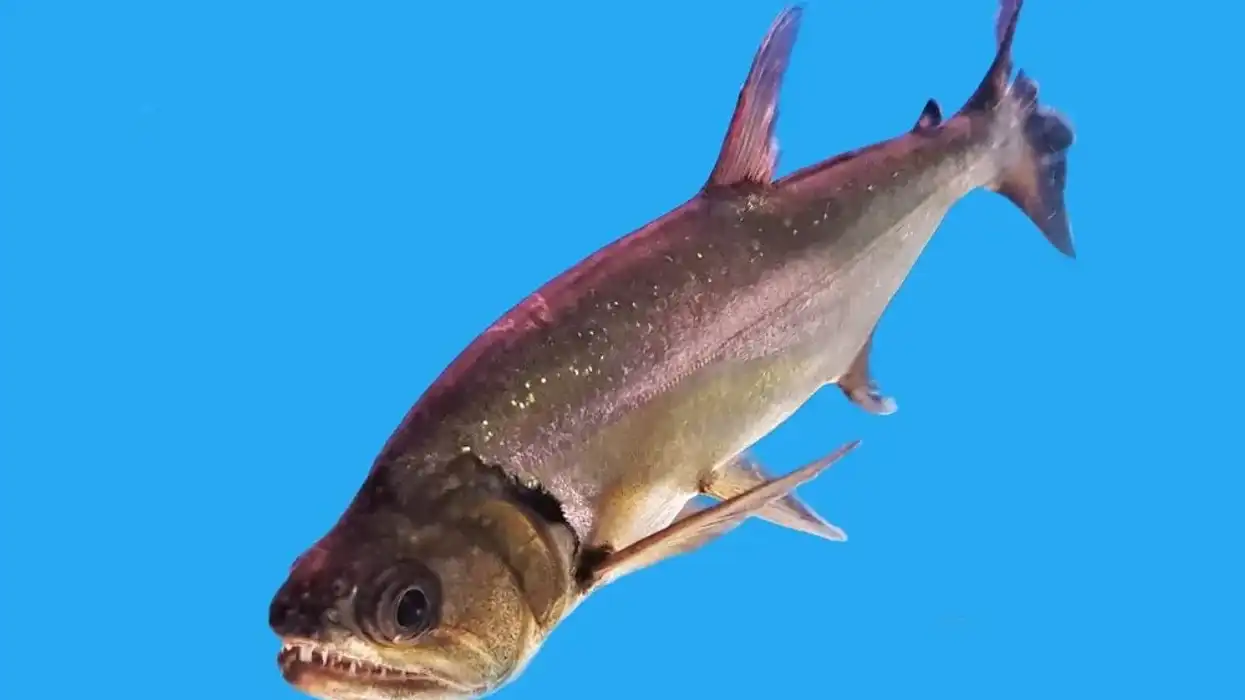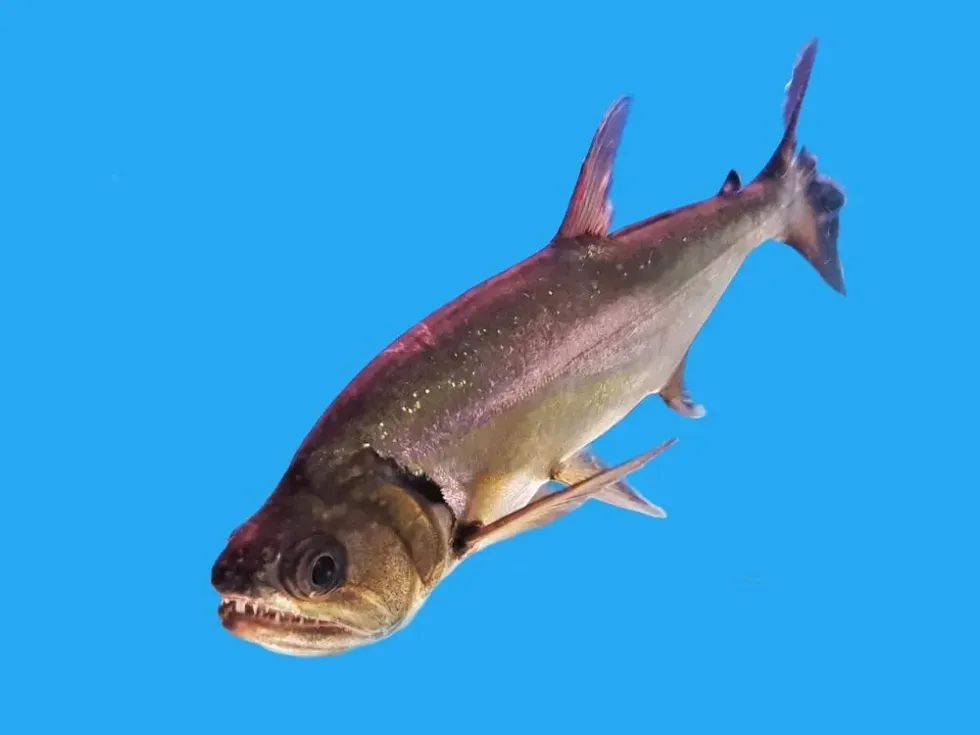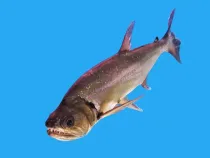Fun Vampire Fish Facts For Kids
The vampire fish is one of the fearsome fish species of the water world. The name 'vampire' is given to these freshwater fishes as they look very scary and have large fangs or teeth. The vampire fish species, known as payara (scientific name: Hydrolycus scomberoides), is also called other names like the dogtooth tetra, wolf-fish, and Dracula fish.
The first thing everyone notices about ‘payara’ is its spiky, prominent, and sharp dagger-like teeth. The payara has two large fangs connected with its lower jaw, which are around 5-6 in (12.7-15.2 cm) in size. Their length is 1-3 ft (30.4-91.4 cm).
The ‘payara’ is an aggressive fish; these fish are hunters that live to eat. Throughout their lifetime, payara are constantly on the move to find their next meal.
There are no known predators found in the marine world of ‘payara’. These fishes have shown the behavior of cannibals who can attack any fish they like, which is why they are known as predatory fish. They also consume the blood of the other fish.
The fangs of the vampire fish, payara, are so strong that their prey can be ripped apart in one go. Their fangs are used for holding, grabbing, and even stabbing the water animals deep. Some fishes like the piranhas are so afraid of payara that they often turn back and hide away before payara attacks them.
Here on our page, we have lots of amazing facts about vampire fish that everyone will enjoy. Let's look at these interesting facts; if you like these, do read our candiru and fangtooth facts.
Vampire Fish Interesting Facts
What type of animal is a Vampire Fish?
The vampire fish, ‘payara’ (Hydrolycus scomberoides), is a large freshwater fish species of the family Cynodontidae. These dogtooth tetra fish are famous for their extensive set of teeth. They are often sold to be in captivity and maintained as a pet in an aquarium despite their aggressive behavior and excessive killing of the other fishes.
What class of animal does a vampire fish belong to?
The vampire fish (payara) is a species of large cannibalism fishes that belong to the class of Actinopterygii fishes. Although the payara does not have any subspecies, these fishes share a genus with three different types of species; the ‘armatus’ is one of them.
‘Payara’ and ‘armatus’ have so many similarities that often people get confused about them. The only difference is that the 'armatus' has a different color than the 'payara'.
How many vampire fishes are there in the world?
Vampire fish (payara) are very rare fishes to be found. These species are not in any danger but are in total abundance and growth in the wild.
They can be found anywhere in zoos or an aquarium, but they always have the title of rare animals. The reason is that these species are hard to catch, and the other thing about these fishes is that they do not reproduce during captivity, and they also have a short lifespan.
Where does a vampire fish live?
The payara fish is a freshwater fish found in its native country, the tropical South America region, mainly in the Amazon basin. These species are also found in some areas of Brazil, mainly in the Venezuala and Rio Tapajos, but they don't go past the natural border of that river and stay in the same territory.
What is a vampire fish's habitat?
The payara fish prefers to stick to the habitat in freshwater that is constantly flowing and has currents. These creatures do not like still water with no activity and are always found in moving water like the sea, river, dams, and streams.
Payara can be easily found on the deep and the bottom side of the waterfall as there is always current and movement.
Apart from the wild, the payara can also be kept in captivity (in a public tank or aquarium in zoos). These large species have very high value, and most people want to keep them as pets.
Who do vampire fishes live with?
Unlike other species of fish, the payara fish does not stay in schools or any large groups, but these toothed creatures are always seen living in solitude. These fish species are very moody, and they cannot tolerate living together or in groups.
They only come together during the migration period as well as breeding season. Also, the payara cannot live with tank mates when kept in captivity.
They will most probably kill their tank mates if you house them together in one aquarium. Therefore, it is better to keep them separated and not in the same aquarium.
How long does a vampire fish live?
The lifespan of the payara fish is not very long. These fishes can live up to two years if kept and very well cared for.
Otherwise, the payara can live till the age of six months to 12 months.
Their short lifespan is because these tropical water creatures eat a lot, and often they eat the infected fish, or otherwise, their body builds an excess amount of nitrogenous waste that kills them.
When they are kept in a tank and aquariums, they expel a large amount of waste into the water, and if the aquariums are not cleaned at that time, they will reach a toxic level, resulting in them getting infected and dying.
How do they reproduce?
Payaras are migratory fish that breed during the start of the monsoon, between November and April. They move from river channels and lakes to the vaster seas, migrating long distances to spawn and feed.
Not much else has been studied about the reproduction of these fishes as they do not replicate the same behavior in captivity, and researchers have not been able to study the reproduction of these fish.
What is their conservation status?
The IUCN does not research the status of these payara, but they are known to have the status of Least Concern animals. And by their growth and population, we can say that they will not be endangered anytime soon.
These creatures are hard to catch; therefore, they are in good population in the wild. They are known to be called vampire fish river monsters because there are no water predators; instead, they are predatory fish and feed on other fishes.
Vampire Fish Fun Facts
What do vampire fish look like?
The vampire fish (payara) is a giant silver-gray fish with some dark hints on the side of its tails and fins. These darker shades and the silver color differentiate them from the other species of the genus Hydrolycus.
The fins of these fish are in a fan-like shape that helps them swim fast in the fast-moving currents. The payara has a prominent face in comparison to their body, and because of the large face, their gills are hidden behind them.
These fishes are given the title of vampire fish because of the long, complex, and spiky teeth on their lower jaw. The two teeth are enormous, larger than their mouth.
These fangs are used to kill their prey in one go and help them to feed on them easily. The fangs make these water catfish fearsome, and even humans fear them. But the studies show that they do not prey on humans but can bite or attack if threatened.

How cute are they?
Vampire (payara) fish are not at all cute-looking fish in the marine world. In fact, because of their massive teeth and their aggressive behavior, the fishes and humans are scared of them. No other fish can stay in the same aquariums and tanks with these creatures as they will become their prey at any time.
How do they communicate?
All fish can hear; however, vampire (payara) fish can make different sounds by vibrating their swim bladder, a muscle they can contract. Payara fish are believed to communicate with one another for specific reasons, including attracting mates, scaring off predators, or orienting themselves.
How big is a vampire fish?
The size of vampire fish (payara) can vary by some inches as these creatures cannot grow large in the aquarium. The average height that a wild vampire fish (payara) can grow up to is 1-3 ft (30.4-91.4 cm) in length.
When kept in the tank, they can grow only up to 12 in (30.4 cm) in total. These creatures are triple the size of the rosy barb fishes.
How fast can a vampire fish swim?
As payaras reside in the deep and fast-moving water, they are known to be fast and strong swimmers; they are used to the deepwater because of their dangerous living habitat. Their fins are built so that they can swim easily in the wild and inside the tank despite their large and heavy figure.
How much does a vampire fish weigh?
As vampire fish (payaras) are large and they can weigh around 10-35 lb (4.5-15.8 kg).
What are the male and female names of the species?
The adult does not have a specific name for the females and males. They are referred to as male payara fishes and female payara fishes.
What would you call a baby vampire fish?
Like every other fish, the baby vampire fish (payaras) is also known as fry. The life stage, the breeding process, the litter size, and every additional information on the young vampire fishes (payaras) are not available and are still unknown to human beings.
What do they eat?
Vampire (payaras) fishes tend to prey on other fishes in marine water. The diet of these creatures contains small fishes like crustaceans, shrimps, minnows, and tetras. They also feed on the larger animals, but they like the taste of the smaller and medium-sized fishes. The favorite diet of this creature contains piranhas fish.
Are they dangerous?
The vampire (payara) fish doesn't pose any actual danger. If you're thinking about a man killing fish, it is probably the Bagarius yarrelli.
Payara fish do not kill any human beings. They appear horrifying however when killing other fishes. People frequently seize vampire fish and pose with them for a quick photoshoot as they seem to be very dangerous and aggressive.
Would they make a good pet?
Payaras are often kept as a pet by many humans. But these creatures are tough to handle.
It is said that only professionals and experienced people can keep them as pets. These fishes required ample space in the aquarium, and they also need attention, time, and dedication.
Payaras often show a change of mood in their behavior; they refuse food and often need various fish.
The negative point is that these fishes do not have a long lifespan and can die within six to 12 months, and it is a rare situation that they can live up to two years since they start producing toxic from their bodies as their diet is heavy, which result in them dying.
Did you know...
Vampire fish facts for kids include that payaras love to dart right into a school of moving fishes and capture their prey in the resulting panic. Payara can eat the whole school of fish alone as food. This is how big the diet of a payara is. It consumes 50% of its body weight.
As per the International Game Fish Association, the largest payara fish ever caught was a specimen caught in the region of Venezuela in 1996. It measured around 3.5 ft (1.06 m) and approximately weighed about 39.4 lb (17.8 kg).
The vampire fish (payara) is often confused with the Hydrolycus armatus because of their similar appearance, but their colors are different.
Some South American villagers hunt payaras for food as these large fish have a lot of meat on their bones. You can eat them, and they don't taste the best, but they can fill you up because of the volume of meat on their bones.
Naming The Vampire Fish
The name 'vampire' is given to the varieties of fishes that look fearsome to some extent. They are given that name also because they drink the blood of the other fishes.
Vampire Fish And Humans
Vampire fish might look like they're straight out of a horror movie, but the great news is that they do not cause any harm to humans. They will not devour you!
Here at Kidadl, we have carefully created lots of interesting family-friendly animal facts for everyone to discover! Learn more about some other fishes, including chum salmon fun facts and cownose ray interesting facts.
You can even occupy yourself at home by coloring in one of our free printable Vampire fish coloring pages.
We Want Your Photos!
More for You
See All
Bachelor of Commerce specializing in Accounting and Finance, Master of Business Administration

Divya RaghavBachelor of Commerce specializing in Accounting and Finance, Master of Business Administration
With a diverse range of experience in finance, administration, and operations, Divya is a diligent worker known for her attention to detail. Born and raised in Bangalore, she completed her Bachelor's in Commerce from Christ University and is now pursuing an MBA at Narsee Monjee Institute of Management Studies, Bangalore. Along with her professional pursuits, Divya has a passion for baking, dancing, and writing content. She is also an avid animal lover who dedicates her time to volunteering for animal welfare causes.
Disclaimer
1) Kidadl is independent and to make our service free to you the reader we are supported by advertising. We hope you love our recommendations for products and services! What we suggest is selected independently by the Kidadl team. If you purchase using the Buy Now button we may earn a small commission. This does not influence our choices. Prices are correct and items are available at the time the article was published but we cannot guarantee that on the time of reading. Please note that Kidadl is a participant in the Amazon Services LLC Associates Program, an affiliate advertising program designed to provide a means for sites to earn advertising fees by advertising and linking to Amazon. We also link to other websites, but are not responsible for their content.
2) At Kidadl, we strive to recommend the very best activities and events. We will always aim to give you accurate information at the date of publication - however, information does change, so it’s important you do your own research, double-check and make the decision that is right for your family. We recognise that not all activities and ideas are appropriate for all children and families or in all circumstances. Our recommended activities are based on age but these are a guide. We recommend that these ideas are used as inspiration, that ideas are undertaken with appropriate adult supervision, and that each adult uses their own discretion and knowledge of their children to consider the safety and suitability. Kidadl cannot accept liability for the execution of these ideas, and parental supervision is advised at all times, as safety is paramount. Anyone using the information provided by Kidadl does so at their own risk and we can not accept liability if things go wrong.
3) Because we are an educational resource, we have quotes and facts about a range of historical and modern figures. We do not endorse the actions of or rhetoric of all the people included in these collections, but we think they are important for growing minds to learn about under the guidance of parents or guardians.







